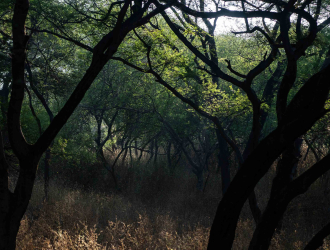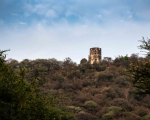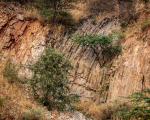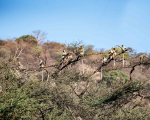Jaipur is a fast-expanding Tier II metro city. A hotspot on the tourism map, tourists throng Hawa Mahal, City Palace, Jantar Mantar, the Pink City and other sites which echo memories of Jaipur’s royalty and its prominent role in the history of Rajputana. Tucked away in the Aravalli Hills surrounding Jaipur are many historic forts like Jaigarh, Nahargarh and Amer, which were used not only for strategic defence purposes but also as hunting lodges, from where shikaar expeditions would be launched in the Aravallis which had big game reserved exclusively for the royal family to hunt.
One such reserve forest in the Aravallis surrounding Jaipur is Jhalana, which was once popular among Jaipur royals for hunting tigers and leopards. Still standing tall above the old boundary walls, overlooking the entire forested valley below is the hunting palace Shikar Oudhi, now open to tourists as a watchtower. The last tigress at Jhalana was shot in 1943 by Gayatri Devi, the erstwhile Maharani of Jaipur, from the ramparts of Shikar Oudhi. Five cubs were recovered and transferred to the Jaipur Zoo, of which two lived to adulthood. Since then, though there have been sporadic sightings of tigers passing through, they ultimately disappeared from Jhalana, and its territories were taken over by the Indian leopard.
Post-Independence, in 1949, Jaipur state merged with the union of India, and Jaipur became capital of a new, much larger state of Rajasthan. As the city expanded, there was every chance that this patch of forest and hills would be encroached by land sharks and mining lobbies. To stop the spread of urban construction in this area, in the early 1960s, Jhalana was declared a reserve forest. This allowed the local wildlife population to slowly revive, and the leopard made its niche as the apex predator of Jhalana. In 2017, with the inception of Project Leopard, Jhalana was officially declared a Leopard Reserve—India’s first leopard protection and conservation programme. In 2020, the leopard census in Jhalana was around 30, a very high number for a 20 sq. km forest area.
The forest cover at Jhalana mostly comprise of kikar (Prosopis juliflora), a species of thorny plant and tall dry grass. Prosopis juliflora is a non-native plant, introduced to provide source of firewood to local villages, but it has since become an invasive species, resulting in reduction of grassland cover. Grasslands are essential for the leopard’s prey and its availability can affect prey density, thus affecting a leopard’s movement pattern and hunting territory.The grasslands also provide excellent camouflage. Their rosette marked pale orange-yellow colour coats help to blend perfectly into the rocky terrain. They are excellent climbers and can be spotted either resting on top of trees or taking a nap in the shadow of thickets.
Another predator in Jhalana is the striped hyena, though unlike the leopard, which is a solo hunter, hyenas scavenge more than they hunt. Earlier when Jhalana had tigers, leopards didn’t have a major presence because they are much smaller in size compared to a tiger and cannot physically compete with them over territory. Although there is overlap, leopards and tigers do not usually share territories. The usual prey base of the leopard are Hanuman langurs, peacocks, wild pigs, chital deer, Indian hare, even squirrels, and unfortunate stray dogs which wander into the forest. Larger game like nilgai—the largest antelope in India— are usually avoided by leopards.
Leopards can be identified from their rosette patterns which is unique for each leopard. Before the forest was declared a Leopard Reserve, a handful of wildlife enthusiasts had started photographing them. They identified and gave individual names to the leopards spotted—like Cleopatra, Simba, Sharmili, Mrs Khan, Discovery, Katrina, Prince, Jalebi, Flora and Bagheera, to name a few of the famous ones. Though located at a stone’s throw distance from Jaipur, Jhalana was not well known before the advent of social media. In the last decade, thanks to Instagram pictures and Facebook groups, Leopards have come into the spotlight, and Jhalana has become a popular destination for wildlife photographers, day tourists and nature enthusiasts.
Human encroachment poses a constant threat to the leopard’s ecosystem. Though banned by the government now, illegal mining in Jhalana forest has resulted in habitat loss. Lack of forest cover drives away prey base and the leopard is forced to look for food elsewhere. Leopards usually hunt smaller prey, so the presence of dogs, goats, chickens, livestock and even monkeys can entice a leopard to sneak into human settlements. However, these violations come at a great cost to a leopard and, if caught, they are heckled, poisoned, snared, shot or sometimes even lynched by humans. The forest department has been stepping up in creating awareness amongst people to not harm the animals. They have been called many times to rescue leopards that have jumped over the boundary and moved into a nearby apartment complex.
To reduce such movement and demarcate boundary of the forest reserve, high fences have been installed along the edges of the forest. This has also controlled illegal grazing inside the forest, which impacts the grassland cover. A concentrated and properly executed plan to preserve and regenerate the grasslands of Jhalana is being followed, allowing the herbivore prey base to increase. New plant saplings are being placed at strategic locations, and citizens are encouraged to donate flowering and fruiting trees from homes. Such trees are transported and replanted by the forest department inside the reserve. These afforestation efforts are being done keeping in mind the native plant species and is helping the forest regain its natural ecological balance and diversity.
Jhalana is connected via a narrow stretch of land to the much larger Nahargarh Wildlife Sanctuary. This green corridor aids in migration and movement of adult leopards from the reserve. But the corridors linking these habitats are fragmented—with highways running through them—and non-existent in most parts. This stretch of the Aravalli shares its boundary with Jaipur’s industrial area, with the main road with heavy traffic only 5 minutes from its entrance gates. Both the forest ecosystem and its big cats are constantly under threat from anthropomorphic activities. Even so, Jhalana is proving to be a role model of sustainable tourism for the protection and preservation of wildlife. When safaris were started, locals were given priority to run them to generate employment, thus making it beneficial for the local economy. Drivers/guides have been trained so that they can provide the best safari experience to guests.Through community participation, this patch of forest is making a success story of the Indian leopard, which is often overlooked for its more famous Panthera cousin, the Bengal Tiger, but is now slowly making its presence felt on the conservation map.
This content has been created as part of a project partnered with Royal Rajasthan Foundation, the social impact arm of Rajasthan Royals, to document the cultural heritage of the state of Rajasthan.

















